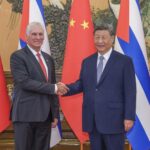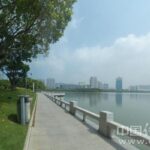Original Title: Reducing Logistics Costs Makes Economic Operations More Efficient
“We must effectively reduce overall social logistics costs, enhance industrial core competitiveness, and improve economic operational efficiency.”
Comprehensive rural revitalization relies on logistics support. Remote rural areas with low population density have long been challenging points for logistics.
Accurate and effective policies have promoted the development of comprehensive and increasingly smooth logistics networks: In 2021, the State Council issued the “Opinions on Accelerating the Construction of Rural Delivery Logistics Systems”; The 2022 Central Document No. 1 proposed accelerating the layout of rural logistics and express delivery outlets and implementing the “Express Delivery to Villages” project; In 2024, the General Office of the Central Committee and the State Council issued the “Action Plan for Effectively Reducing Overall Social Logistics Costs”.
Mingunger Village in Awati Township, Korla City, has become a free shipping area for online shopping in recent years.
“Ding!” After lunch, villager Xing Baobao received a text message that the tissues he purchased online a few days ago had arrived. “Pretty fast delivery, and most importantly, free shipping!”
Less than one kilometer from his home is the village’s express delivery point, with shelves filled with packages. Staff explained: “Packages are uniformly delivered to the delivery point through postal-express cooperation. When sending packages, villagers bring them here, and then couriers collect them uniformly.”
The goal is both to help farmers sell products effectively and profitably, and to enable farmers to purchase goods conveniently and affordably. The continuous expansion of free shipping areas has facilitated people’s production and daily life, and has become an important window reflecting the cost reduction and efficiency improvement in logistics.
The rural delivery logistics network extends across vast rural areas. As an example, by the end of 2024, there were 1,537 postal service outlets and 7,920 village-level comprehensive delivery logistics service stations, achieving basically full coverage of express delivery services in administrative villages.
To achieve free shipping for packages, postal and express delivery enterprises collaborated with e-commerce platforms, establishing transit and consolidation warehouses in places like Xi’an, Shaanxi and Hangzhou, Zhejiang. This created a new delivery model where national parcels are first sent to consolidation warehouses before being collectively dispatched, leveraging economies of scale to significantly reduce shipping costs. “Even time-sensitive fresh products can now enjoy free shipping,” said Xing Baobao.
The increasingly dense logistics network helps more distinctive agricultural products reach various parts of the country. In 2024, the express delivery receipt-to-delivery ratio narrowed from the previous year’s 3.05:1 to 2.54:1, while rural online retail sales increased by 18.18% and agricultural product online retail sales grew by 14.08%.
Nationwide, 346,000 village-level comprehensive delivery logistics service stations have been established, with express delivery service coverage exceeding 95% in administrative villages. Over 100 million express packages flow through rural areas daily. In Shaanxi, apples and kiwifruit travel out of mountainous areas via express networks; In Yunnan, flowers and coffee reach overseas markets through cross-border logistics… The continuous improvement of rural delivery logistics systems has strongly promoted the flow of urban and rural resource elements and stimulated rural development momentum.
The flow of consumer goods to villages and agricultural products to cities has made urban-rural circulation smoother, vividly demonstrating the principle of “allowing the masses to obtain tangible benefits they can see and touch.”
As the construction of a unified national market advances deeply, the “capillaries” of road, rail, waterway, and air networks continue to enrich, making logistics more convenient and smooth, injecting powerful momentum into efficient economic operations.
On land, the construction of the Chengdu-Chongqing Main Axis Highway Logistics Park is racing against time, striving towards the goal of full operation by year-end. Upon completion, it will become the largest highway logistics hub in the central region of the Chengdu-Chongqing main axis.
On water, the fully navigable Jianghuai Canal has changed the history of water transport between the Huai River region and the Yangtze River region requiring detours via the Beijing-Hangzhou Grand Canal, significantly shortening shipping distances and voyage cycles.
In the air, Asia’s first professional cargo hub airport – Ezhou Huahu International Airport – extends freight routes outward, building an air cargo network radiating across Asia, connecting Europe and America, and reaching Africa.
Smoother logistics networks create stronger economic pulses. On the new journey ahead, continuously promoting logistics cost reduction and quality improvement will further unblock national economic circulation and help improve economic operational efficiency.



